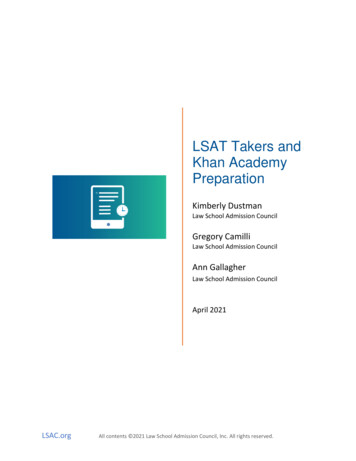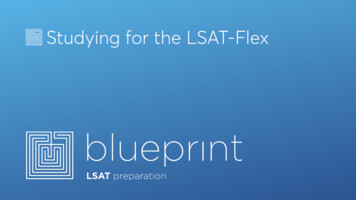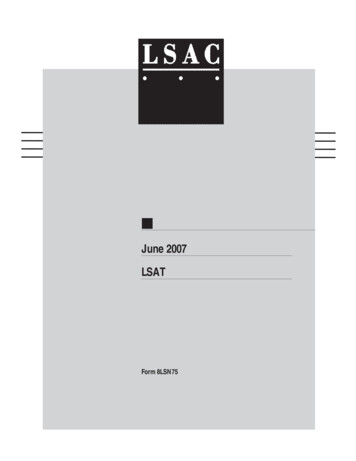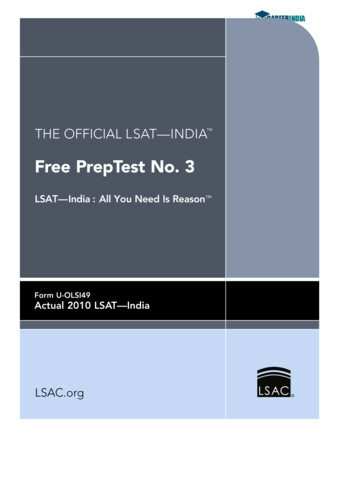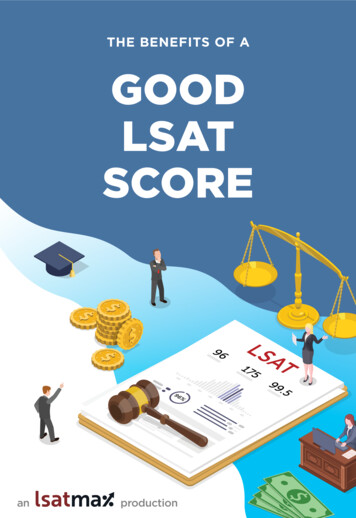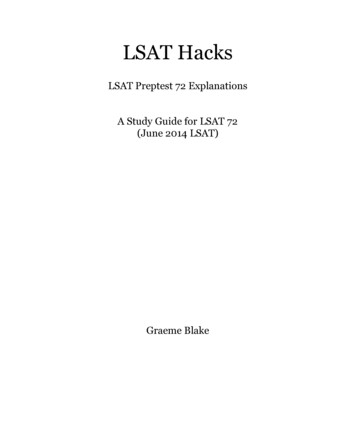
Transcription
LSAT HacksLSAT Preptest 72 ExplanationsA Study Guide for LSAT 72(June 2014 LSAT)Graeme Blake
Copyright 2014 by Graeme BlakeBlake PublicationsMontreal, Canadawww.lsathacks.comALL RIGHTS RESERVED. This book contains material protected under Internationaland Federal Copyright Laws and Treaties. Any unauthorized reprint or use of thismaterial is prohibited. No part of this book may be reproduced or transmitted in anyform or by any means, electronic or mechanical, including photocopying, recording, orby any information storage and retrieval system without express written permissionfrom the author / publisher.LSAT is copyright of the LSAC. The LSAC has not reviewed or endorsed this material.ISBN 13: 978-1-927997-07-9ISBN 10: 1-927997-07-02
TestimonialsSelf-study is my preferred way to prep, but I oftenfelt myself missing a few questions each test.Especially for Logic Games, I wanted to see thosekey inferences which I just couldn't seem to spot onmy own. That's where LSAT Hacks came in. Thesesolutions have been a tremendous help for my prep,and in training myself to think the way anexperienced test taker would.LSAT PrepTests come with answer keys, but it isn'tsufficient to know whether or not you picked thecredited choice to any given question. The keyto making significant gains on this test isunderstanding the logic underlying the questions.This is where Graeme's explanations really shine.You may wonder whether your reasoning for aspecific question is sound. For the particularlychallenging questions, you may be at a complete lossas to how they should be approached.- Spencer B.Graeme paraphrases the question in plain terms,and walks through each step in obtaining the rightanswer in a very logical way. This book uses thesame techniques as other guides, but its so muchmore consistent and concise! By the time you readthrough all the tests, you've gradually developedyour eye for the questions. Using this book is a greatway to test your mastery of techniques!Having these questions explained by Graeme whoscored a 177 on the test is akin to hiring an elite tutorat a fraction of the price. These straightforwardexplanations will help you improve yourperformance and, more fundamentally, enhanceyour overall grasp of the test content.- Morley Tatro, Cambridge LSAT,www.cambridgelsat.com- Sara L.Graeme's explanations have the most logical andunderstandable layout I've seen in an LSAT prepbook. The explanations are straightforward and easyto understand, to the point where they make yousmack your forehead and say 'of course!Through his conversational tone, helpfulintroductions, and general recommendations andtips, Graeme Blake has created an enormouslyhelpful companion volume to The Next Ten ActualOfficial LSATs. He strikes a nice balance betweenproviding the clarity and basic explanation of thequestions that is needed for a beginner anddescribing the more complicated techniques that arenecessary for a more advanced student.- Michelle V."Graeme is someone who clearly demonstrates notonly LSAT mastery, but the ability to explain it in acompelling manner. This book is an excellentaddition to whatever arsenal you're amassing totackle the LSAT."Even though the subject matter can be quite dry,Graeme succeeds in making his explanations funand lighthearted. This is crucial: studying for theLSAT is a daunting and arduous task. By injectingsome humor and keeping a casual tone, the painfulprocess of mastering the LSAT becomes a little lesspainful.- J.Y. Ping, 7Sage LSAT,www.7Sage.comI did not go through every single answer but ratherused the explanations to see if they could explainwhy my answer was wrong and the other correct. Ithought the breakdown of "Type", "Conclusion","Reasoning" and "Analysis" was extremely useful insimplifying the question. As for quality of theexplanations I'd give them a 10 out of 10.When you use LSAT Hacks in your studying, youwill feel like you have a fun and knowledgeable tutorguiding you along the way.- Law Schuelke, LSAT Tutor,www.lawLSAT.com- Christian F.3
Graeme's explanations are clear, concise andextremely helpful. They've seriously helped meincrease my understanding of the LSAT material!LSAT Hacks, especially the logic games sections, wasextremely helpful to my LSAT preparation.The one downside to self study is that sometimes wedo not know why we got a question wrong andthus find it hard to move forward. Graeme’s bookfixes that; it offers explanations and allows you tosee where you went wrong. This is an extremelyhelpful tool and I'd recommend it to anybody that'slooking for an additional study supplement.- Jason H.Graeme’s book brings a different view todemystifying the LSAT. The book not only explainsthe right and wrong answers, but teaches you how toread the reading comprehension and the logicalreasoning questions. His technique to set up thegames rule by rule help me not making any fatalmistakes in the set up. The strategies he teaches canbe useful for someone starting as much as forsomeone wanting to perfect his strategies. Withouthis help my LSAT score would have been average, hebrought my understanding of the LSAT and myscore to a higher level even if english is not mymother tongue.- Joseph C.Regardless of how well you're scoring on the LSAT,this book is very helpful. I used it for LR and RC. Itbreaks down and analyzes each question without thedistraction of classification and complicatedmethods you'll find in some strategy books. Insteadof using step-by-step procedures for each question,the analyses focus on using basic critical thinkingskills and common sense that point your intuition inthe right direction. Even for questions you're gettingright, it still helps reinforce the correct thoughtprocess. A must-have companion for reviewing preptests.- Patrick Du.This book is a must buy for any who are looking topass or improve their LSAT, I highly recommend it.- Patrick Da.- Christine Y.This book was really useful to help me understandthe questions that I had more difficulty on. When Iwas not sure as to why the answer to a certainquestion was that one, the explanations helped meunderstand where and why I missed the rightanswer in the first place. I recommend this book toanyone who would like to better understand themistakes they make.Take a thorough mastery of the test, an easygoingdemeanor, and a genuine desire to help, and you'vegot a solid resource for fine-tuning your approachwhen you're tirelessly plowing through test aftertest. Written from the perspective of a test-taker,this book should help guide your entire thoughtprocess for each question, start to finish.- Pamela G.- Yoni Stratievsky, Harvard Ready,www.harvardready.comGraeme's book is filled with thoughtful and helpfulsuggestions on how to strategize for the LSAT test. Itis well-organized and provides concise explanationsand is definitely a good companion for LSATpreparation.This LSAT guide is the best tool I could have whenpreparing for the LSAT. Not only does Graeme do agreat job of explaining the sections as a whole, healso offers brilliant explanations for each question.He takes the time to explain why an answer iswrong, which is far more helpful when trying toform a studying pattern.- Lydia L.The explanations are amazing, great job. I can hearyour voice in my head as I read through the text.- Amelia F.- Shawn M.4
LSA T 7 2 E xpl anat ionsT a bl e O f C o n t e n t sIntroduction6How To Use This Book7Short Guide to Logical Reasoning8A Few Logic Games Tips10Section I – Reading Comprehension11Passage 1 – Forest Fires11Passage 2 – Mali and UNESCO15Passage 3 – Equipoise20Passage 4 – Flat Tax (comparative)26Section II – Logical Reasoning31Section III – Logical Reasoning47Section IV – Logic Games61Game 1 – Radio Station61Game 2 – Five Houses66Game 3 – Sunken Artifacts71Game 4 – Summit Workpieces76Appendix: LR Questions By Type79Thank You81About The Author82Further Reading83Free LSAT Email Course845
INTRODUCTIONIntroductionThe LSAT is a hard test.Reading Comprehension: You should form amental map of the passage. This helps you locatedetails quickly. Make a 1-2 line summary of eachparagraph (it can be a mental summary).The only people who take the LSAT are smart peoplewho did well in University. The LSAT takes the verybest students, and forces them to compete.I’ve written my own summaries for each passage.They show the minimum amount of informationthat you should know after reading a passage,without looking back.If the test’s difficulty shocked you, this is why. TheLSAT is a test designed to be hard for smart people.That’s the bad news. But there’s hope. The LSAT is astandardized test. It has patterns. It can be learned.I’ve included line references in my explanations. Youdo not need to check these each time. They’re onlythere in case you aren’t sure where something is.To get better, you have to review your mistakes.Many students write tests and move on, withoutfully understanding their mistakes.Do these three things, and you can answer mostReading Comprehension questions with ease.:This is understandable. The LSAC doesn’t publishofficial explanations for most tests. It’s hard to besure why you were wrong.1. Know the point of the passage.2. Understand the passage, in broad terms. Rereadanything you don’t understand.3. Know where to find details. That’s the point of theparagraph summaries. I usually do mine in my head,and they’re shorter than what I’ve written.That’s where this book comes in. It’s a companion forLSAT 72, the June 2014 LSAT.This book lets you see where you went wrong. It hasa full walk through of each question and of everyanswer choice. You can use this book to fix yourmistakes, and make sure you understandeverything.Review This BookBefore we start, I’d like to ask you a favor. I’m anindependent LSAT instructor. I don’t have amarketing budget.By getting this book, you’ve shown that you’reserious about beating this test. I sincerely hope ithelps you get the score you want.But I do my best to make good guides to the LSAT. Ifyou agree, I would love it if you took two minutes towrite a review on amazon.comThere are a few things that I’d like to highlight.People judge a book by its reviews. So if you like thisguide you can help others discover it. I’d be verygrateful.Logical Reasoning: It can be hard to identifyconclusions in LR. You don’t get feedback onwhether you identified the conclusion correctly.Good luck!This book gives you that feedback. I’ve identified theconclusion and the reasoning for each argument. Tryto find these on your own beforehand, and makesure they match mine.Graemep.s. I’m a real person, and I want to know how theLSAT goes and what you think of this book. Send mean email at graeme@lsathacks.com!Logic Games: Do the game on your own beforelooking at my explanation. You can’t think about agame unless you’re familiar with the rules. Once youread my explanations, draw my diagrams yourselfon a sheet of paper. You’ll understand them muchbetter by recopying them.p.p.s. For more books, check out the furtherreading section at the back. I’m also offering a freehalf hour LSAT lesson if you fill out a survey.6
INTRODUCTIONHow To Use This BookThe word “Hacks” in the title is meant in thesense used by the tech world and Lifehacker:“solving a problem” or “finding a better way”.Logic games also deserve special mention.Diagramming is a special symbolic language thatyou have to get comfortable with to succeed.The LSAT can be beaten, but you need a goodmethod. My goal is for you to use this book tounderstand your mistakes and master the LSAT.If you just look at my diagrams without makingthem yourself, you may find it hard to follow along.You can only learn a language by using it yourself.This book is not a replacement for practicing LSATquestions on your own.So you will learn much more if you draw thediagrams on your own. Once you’ve seen howI do a setup, try to do it again by yourself.You have to try the questions by yourself first. Whenyou review, try to see why you were wrong beforeyou look at my explanations.With constant practice, you will get better atdiagramming, and soon it will come naturally.Active review will teach you to fix your ownmistakes. The explanations are there for when youhave difficulty solving on a question on your own orwhen you want another perspective on a question.But you must try on your own. Draw the diagrams.Note that when you draw your own diagrams, youdon’t have to copy every detail from mine. Forexample, I often leave off the numbers when I dolinear games. I’ve included them in the book,because they make it easier for you to follow along.When you do use the explanations, have thequestion on hand. These explanations are not meantto be read alone. You should use them to help youthink about the questions more deeply.But under timed conditions, I leave out many detailsso that I can draw diagrams faster. If you practicemaking drawings with fewer details, they becomejust as easy to understand.Most of the logical reasoning explanations are prettystraightforward. Necessary assumption questionsare often an exception, so I want to give you someguidance to help you interpret the explanations.Keep diagrams as minimal as possible.The easiest way to test the right answer on anecessary assumption question is to “negate” it.If you simply don’t like the way I draw a certain ruletype, then you can substitute in your own style ofdiagram. Lots of people succeed using differentstyles of drawing.You negate a statement by making it false, in theslightest possible way. For example, the negationof “The Yankees will win all their games” is “TheYankees will not win all their games (they will loseat least one).”Just make sure your replacement is easy to drawconsistently, and that the logical effect is the same.I’ve chosen these diagrams because they are clear,they’re easy to draw, and they keep you fromforgetting rules.You don’t have to say that the Yankees will loseevery game. That goes too far.If the negation of an answer choice proves theconclusion wrong, then that answer is necessary tothe argument, and it’s the correct answer.I’ve included line references to justify ReadingComprehension Answers. Use these only in caseyou’re unsure about an explanation. You don’t haveto go back to the passage for every line reference.Often, I negate the answer choices when explainingnecessary assumption questions, so just keep inmind why they’re negated.7
INTRODUCTIONShort Guide to Logical ReasoningLR Question TypesNecessary Assumption: The correct answer will beessential to the argument’s conclusion. Use thenegation technique: If the correct answer is false(negated), then the argument falls apart.The negation of hot is “not hot” rather than cold.Must be True: The correct answer is true.Most Strongly Supported: The correct answer isprobably true.Here’s how to do negations: You just make the ideafalse. This is not so much about grammar as it isabout thinking what the idea is, and acounterexample. E.g.Strengthen/Weaken: The answer is correct if iteven slightly strengthens/weakens the argument.Parallel Reasoning: The correct answer will mirror“All Americans are nice” “One guy in Arkansasnamed Bob is sort of mean. Every single otherAmerican is always really nice”the argument’s structure exactly. It is often useful todiagram these questions (but not always).Sufficient Assumption: The correct answer willprove the conclusion. It’s often useful to diagramsufficient assumption questions. For example:The “grammatical” negation is “not all Americansare nice”, but it’s so much clearer and easier to thinkin terms of making the idea not true.The conclusion is: A DPoint at Issue: Point at Issue questions require twoThere is a gap between premises and conclusion:things. 1. The two speakers must express an opinionon something. 2. They must disagree about it.AB C DA B CA BDC Dmissing link: A B or B AFlawed Reasoning: The correct answer will be amissing link: C D or D Cdescription of a reasoning error made in theargument. It will often be worded very abstractly.missing link: B C or C BPractice understanding the answers, right andwrong. Flawed Reasoning answers are very abstract,but they all mean something. Think of examples tomake them concrete and easier to understand.The right answer will provide the missing link.8
INTRODUCTIONGeneral Advice: Always remember what you areBasic Logiclooking for on each question. The correct answer ona strengthen question would be incorrect on aweaken question.Take the phrase: “All cats have tails.”Watch out for subtle shifts in emphasis between thestimulus and the incorrect answer choices. Anexample would be the difference between “howthings are” and “how things should be.”“Cats” is the sufficient condition. Knowing thatsomething is a cat is “sufficient” for us to say that ithas a tail. “Tails” is a necessary condition, becauseyou can’t be a cat without a tail. You can draw thissentence as C TJustify your answers. If you’re tempted to choose ananswer choice that says something like the sentencebelow, then be sure you can fill in the blank:The contrapositive is a correct logical deduction,and reads “anything without a tail is not a cat.” Youcan draw this as T C. Notice that the terms arereversed, and negated.Answer Choice Says: “The politician attacked hisopponents’ characters”,Incorrect Reversal: “Anything with a tail is a cat.”Fill In The Blank: “The politician saidabout his opponents’ characters.”This is a common logical error on the LSAT.T C(Wrong! Dogs have tails and aren’t cats. )If you cannot say what the attack was, you can’t pickthat answer. This applies to many things. You mustbe able to show that the stimulus supports your idea.Incorrect Negation: “If it is not a cat, it doesn’thave a tail.” This is another common error.C T (Wrong! Dogs aren’t cats, but have tails.)9
INTRODUCTIONA Few Logic Games TipsRule 1: When following along with my explanations.draw the diagrams yourself, too!This book will be much more useful if you try thegames by yourself first. You must think throughgames on your own, and no book will do that foryou. You must have your mind in a game to solve it.If you don’t think you have time to draw diagramsfor each question, practice drawing them faster. It’sa learnable skill, and it pays off.Try To Eliminate a Few Easy Answer ChoicesFirst: You’ll see examples in the explanations thatshow how certain deductions will quickly get rid of1-3 answer choices on many questions. This savestime for harder answer choices and it frees upmental space.Use the explanations when you find a game you can’tunderstand on your own, or when you want to knowhow to solve a game more efficiently.Some of the solutions may seem impossible to get onyour own. It’s a matter of practice. When you learnhow to solve one game efficiently, solving othergames becomes easier too.You don’t have to try the answer choices in order,without thinking about them first.Try to do the following when you solve games:Split Games Into Two Scenarios WhenAppropriate: If a rule only allows something to beone of two ways (e.g. F is in 1 or 7), then draw twodiagrams: one with F in 1, and one with F in 7. Thisleads to extra deductions surprisingly often. And italways makes the game easier to visualize.Work With What Is Definite: Focus on whatmust be true. Don’t figure out every possibility.Draw Your Deductions: Unsuccessful studentsoften make the same deductions as successfulstudents. But the unsuccessful students forget theirdeductions, 15 seconds later! I watch this happen.Combine Rules To Make Deductions: Look forvariables that appear in multiple rules. These canoften be combined. Sometimes there are nodeductions, but it’s a crime not to look for them.Draw your deductions, or you’ll forget them. Don’tbe arrogant and think this doesn’t happen to you. Itwould happen to me if I didn’t draw my deductions.Reread The Rules: Once you’ve made yourdiagram, reread the rules. This lets you catch anymistakes, which are fatal. It doesn’t take very long,and it helps you get more familiar with the rules.Draw Clear Diagrams: Many students waste timelooking back and forth between confusing pictures.They’ve done everything right, but can’t figure outtheir own drawings!Draw Rules Directly On The Diagram: Mentalspace is limited. Three rules are much harder toremember than two. When possible, draw rules onthe diagram so you don’t have to remember them.You should be able to figure out your drawings 3weeks later. If you can’t, then they aren’t clearenough. I’m serious: look back at your old drawings.Can you understand them? If not, you need a moreconsistent, cleaner system.Memorize Your Rules: You should memorizeevery rule you can’t draw on the diagram. It doesn’ttake long, you’ll go faster, and you’ll make fewermistakes. Try it, it’s not that hard.Draw Local Rules: When a question gives you anew rule (a local rule), draw it. Then look fordeductions by combining the new rule with yourexisting rules. Then double-check what you’re beingasked and see if your deduction is the right answer.This works 90% of the time for local rule questions.And it’s fast.If you spend 30 seconds doing this, you’ll often savea minute by going through the game faster.You should also make a numbered list of rules thataren’t on the diagram, in case you need to checkthem.10
LSAT 72 – SECTION I, RCSect ion I – R eading ComprehensionPassage 1 – Forest FiresQuestions 1–6Paragraph SummariesWhen I do a passage, I remember a lot of detailswithout trying, just because I read carefully, andreread if I don’t understand. I also skim the passagebefore starting. This all helps retention.1. Too much firefighting can be bad. Forests, suchas ancient ponderosa forests, have regular cyclesof fire. Most large trees survived these fires, andthe fires cleared away brush.2. If there are no fires, fuel builds up. Then whenthere is a fire, the whole forest can be destroyed.3. Three factors cause fires: Topography, weatherand fuel. Only fuel can be controlled byfirefighters. They can reduce fuel by selectiveharvesting and controlled fires. Once fuel isreduced, there should be maintenance fires every15-20 years.Knowing many details helps you sift throughanswers faster. You can judge what matches thepassage, and what is put there as a trap.Now, let’s talk about the subject of the passage. Thispassage is based on real life, by the way. In NorthAmerica, we’ve prevented forest fires fromhappening. So our forests have lots of small treesand deadwood.When a fire does happen and we can’t stop it, thefire quickly grows out of control. It burns everything,even the large trees. The forest can die entirely.This isn’t how forests used to work. In the past, firesoccurred at regular intervals. The fires killed smalltrees, and removed deadwood. But the large treessurvived.AnalysisThis passage has a lot of details. It’s important foryou to have two things:1. A good understanding and summary of theDeadwood and small trees are what allow fires togrow. If you’ve ever made a campfire, you’ll knowthat the big logs won’t burn right away. You need tolight smaller branches that let the fire burn stronglybefore the big logs will catch fire. Likewise, the largetrees in forests only burn because smaller trees anddeadwood let the fire burn strong enough.argument.2. A grasp of the details. You don’t need tomemorize them, but you should know roughlywhere they are.The argument can be summarized like this:“If we stop all wildfires, fuels burn up in forests. Thiseventually leads to devastating fires. We shouldreduce excess fuel, and then allow controlled burnsto periodically clear fuel from forests.”So if we stop small fires, then fuel builds up inforests and when fires do happen, they are intense.The passage says that many North American forestsnow have an excess of fuel. So we currently can’t letfires happen. They’d be too strong. Instead, we haveto clear small trees and deadwood from forests.Once enough fuel is cleared, fires will be less intense.If you understand that, then you can get mostquestions.Next, a word about details. I said you shouldn’tintentionally memorize details. But that doesn’tmean you can forget everything.So after we’ve cleared enough fuel, we can startcontrolled burns, and let natural fires burn ifconditions are damp enough. These periodic fireswill clear brush, meaning we will no longer have theproblem of excess fuel buildup in forests.11
LSAT 72 – SECTION I, RCQuestion 1Question 2DISCUSSION: The purpose of the passage is toDISCUSSION: Reread around line 55 for the fulldescribe a problem in forest management(paragraphs 1 and 2) and recommend a solution(paragraph 3).context of this question. The author isrecommending two steps:1. Reduce excess fuel, so that fires won’t be horriblyA. The passage never talked about ideology. And the2. Once excess fuel is removed, allow maintenancedestructive.burns every 15-20 years.author never said anyone is resisting the change.It’s possible that everyone wants to fix the forestfire problem. Our current situation could havesimply been the result of a mistake, rather thanany partisan ideology.B. The passage doesn’t describe two differentpolicies that have been put into place. Thepassage describes the results of one policy thathas been in place (stopping all fires). Then thepassage recommends putting another policy intoplace (fuel reduction and controlled burns). Onlythe first policy has actually been in place.C. The passage never mentions funding.D. CORRECT. Paragraphs 1 and 2 show thatcurrent policy has had bad results – forests arepowder kegs that may suffer massive fires. Thepolicy change is in paragraph 3: remove excessfuel and then allow periodic forest fires.E. This answer describes a completely differentsituation. There’s no contradiction in therecommended policy. Allowing controlled forestfires isn’t contradictory to the goal of avoidingdestructive fires. Instead, it supports the goal ofavoiding destructive fires.It sounds like the periodic fires every 15-20 yearswill maintain the lower level of fuel in the forests.Lines 50-54 describe these fires. They’re eithercontrolled burns we set ourselves, or fires caused bylightning when conditions are damp.A. Not quite, though I can see how this is tempting.“Maintenance burns” doesn’t just refer to the oldstyle of fire. If it did, then we would never setfires, and we would allow lightning fires to burneven if conditions were dry. Lines 50-54 showthat the author instead recommends intentionalfires, and letting lightning fires burn only whenconditions are damp.B. The author recommends reducing the density ofyoung, small trees. Mature trees are the ones wewant to leave standing. See lines 12-14.C. Modern North American forests have too muchfuel. If we allow fires to occur before we removefuel, they fires will be very destructive. See lines27-31.D. No fires used to occur at intervals “greater than50 years”. 50 years is only referenced in line 30 –it’s the length of time we have prevented firesfrom occurring in forests.E. CORRECT. See lines 50-54. They say thatmaintenance burns are fires that we set andcontrol, or lightning fires that we allow to burnwhen conditions are damp.Also, if this were the right answer, then thepassage would have started by describing thenew policy and the apparent contradiction.Instead, the passage started by describing theproblems of the old policy.12
LSAT 72 – SECTION I, RCQuestion 3Question 4DISCUSSION: The first two paragraphs describeDISCUSSION: Look at lines 36-41. They say thathow modern forest management has made forestsvulnerable to devastating crown fires.there are three relevant factors: topography, weatherand fuel.The third paragraphs describes a two step solution:We can only control fuel, so that’s where we shouldfocus.1. In the short term, remove excess fuel by brushclearing.2. In the long term, allowed controlled fires to keepfuel at low levels.A. CORRECT. Read lines 39-41 in particular. Theysay that fuel is the only one of the three elementswe can control, so we should focus there.B. This contradicts the passage. The point of thethird paragraph is to show that we can controlwildfires and help forests return to a healthierstate with less fuel.C. Nonsense. It’s paragraphs 1 and 2 that show whyforests fires are more destructive.D. This is total nonsense. It takes words used in thepassage, and combines them in a way thatdoesn’t have much meaning. Lines 36-40 werefairly clear, and they have nothing to do with thisanswer.There’s nothing much else to say except to pointout that the passage did not argue that specificfuel types are dependent on weather.E. Lightning is part of weather. But that’s as far asthis goes. Read lines 39-41. They explain thepurpose of the three factors: we can only controlfuel, so we should focus there.To continue the paragraph, the answer should berelated to this two part solution or it’s likely results.All the wrong answers introduce new topics. Thethird paragraph is unlikely to introduce a new topicat the very end of the passage.A. The passage never talked about damage tohomes. The third paragraph is unlikely tointroduce a new topic right at the end.B. The passage never said that any foresters resistthese proposals. The third paragraph is unlikelyto introduce a new topic right at the end.C. CORRECT. This is a valid continuation.Paragraphs 1 and 2 described the dangers of ourpresent situation. Paragraph 3 described asolution. This answer cautions that the dangerdescribed in paragraphs 1 and 2 will still be withus for at least several years, even if we implementthe solution.D. The passage never mentioned economic impactsand it did not mention timber companies. Thethird paragraph is unlikely to introduce newtopics right at the end.E. The passage never talked about financialresources or whether this proposal could beimplemented in practice. The third paragraph isunlikely to introduce a new topic right at the end.13
LSAT 7
read the reading comprehension and the logical reasoning questions. His technique to set up the games rule by rule help me not making any fatal mistakes in the set up. The strategies he teaches can be useful for someone starting as much as for someone wanting to perfect his strategies. Without his help m
